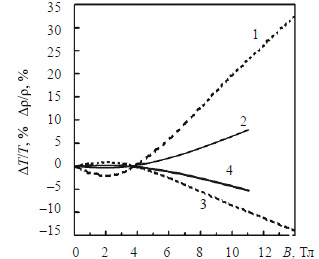Cryogenic resistance thermometers based on Ge-InP films
Abstract
Despite the large number of scientific articles devoted to the development of cryogenic resistance thermometers, not many of these thermometers are mass-produced. As is know, semiconductor resistive temperature sensors have low magnetoresistance and high resistance to radiation. The purpose of this work was to manufacture thin (170-190 nm) Ge films on semi-insulating InP substrates, which can be used to create cryogenic resistance thermometers with high temperature sensitivity and relatively low sensitivity to magnetic field that can operate in the 1.5–400 K temperature range.
Films of Ge on InP (100) can be used to produce cryogenic resistance thermometers. They have good thermal sensitivity and relatively low magnetoresistance.
The films were produced by thermal evaporation of Ge in vacuum (2·10–4 Pa) on semi-insulating InP (100) substrates. The temperature of the InP substrate during film deposition was 310°C, the deposition rate was also constant during sputtering, but varied in the range of 0.03 to 0.06 nm/s for different films. Ge films were p-type conductivity with a resistivity of 0.2-0.3 Ω·cm, hole concentration (3–5)·1018 cm–3 and Hall mobility 6.5–7.5 cm2/(V·s) at room temperature.
The quality of the Ge-InP heterostructure was determined by high-resolution X-ray diffraction on a Philips MRD diffractometer. The nanomorphology of the surface of Ge films was studied using the NanoScope IIIa atomic force microscope. The crystal structure of the films is amorphous or polycrystalline with a low level of structural perfection. The effective value of the surface roughness is from 2.25 to 2.60 nm.
The obtained resistance values at different temperature in the range of 2–25 K were described by exponential dependence. Corrections in temperature measurement are 5% in a magnetic field of 11 T at a temperature of 4.2 K and 14% in a magnetic field of 14 T at a temperature of 2.2 K.
The research results indicate that the obtained films can be used to measure cryogenic temperatures in magnetic fields of up to 14 T.
References
Rubin L.G. Cryogenic thermometry: a review of progress since 1982. Cryogenics, 1997, vol. 37, iss. 7, pp. 341–356. https://doi.org/10.1016/S0011-2275(97)00009-X
Childs P.R.N., Greenwood J.R., and Long C.A. Review of temperature measurement. Review of Scientific Instruments, 2000, vol. 71, iss. 8, pp. 2959. https://doi.org/10.1063/1.1305516
Yeager C.J, Courts S.S. A review of cryogenic thermometry and common temperature sensors. IEEE Sensors Journal, 2001, vol. 1, iss. 4, pp. 352–360. https://doi.org/10.1109/7361.983476
Brant B.L., Liu D.W., Rubin L.G. Low temperature thermometry in high magnetic fields VII. Cernox.sensors to 32 T. Review of Scientific Instruments, 1999, vol. 70, iss. 1, pp. 104. https://doi.org/10.1063/1.1149549
Yotsuya T., Kakehi Y., Ishida T. Thin film temperature sensor for cryogenic region with small magnetoresistance. Cryogenics, 2011, vol. 51, iss. 9, pp. 546–549. https://doi.org/10.1016/j.cryogenics.2011.07.005
Zhenzhen Hui, Qiumin Meng, Renhuai Wei et al. CrN thin films with ultra-low magnetoresistance prepared via solution processing for large-area applications. Journal of Alloys and Compounds, 2017, vol. 696, p. 844–849. https://doi.org/10.1016/j.jallcom.2016.12.048
Mitin V.F., McDonald P.C., Pavese F. et al. Ge-on-GaAs film resistance thermometers for cryogenic applications. Cryogenics, 2007, vol. 47, iss. 9–10, pp. 474–482. https://doi.org/10.1016/j.cryogenics.2007.04.014
Mitin V.F., Kholevchuk V.V., Kolodych B.P. Ge-on-GaAs film resistance thermometers: Low-temperature conduction and magnetoresistance, Cryogenics, 2011, vol. 51, iss. 1, p. 68–73. https://doi.org/10.1016/j.cryogenics.2010.11.003
Zarubin L.I., Nemish I.Y., Szmyrka-Grzebyk A. Germanium resistance thermometers with low magnetoresistance. Cryogenics, 1990, vol. 30, iss. 6, p. 533–537. https://doi.org/10.1016/0011-2275(90)90055-H
Courts S.S. High level gamma radiation effects on Cernox TM cryogenic temperature sensors. IOP Conf. Series: Materials Science and Engineering, 2017, vol. 278, 012076. https://doi.org/10.1088/1757-899X/278/1/012076
Filippov Yu.P., Golikov V.V., Kulagin E.N., Shabratov V.G. Effects of high intensity cryogenic irradiation and magnetic field on temperature sensors. Advances in Cryogenic Engineering, 1998; vol. 43, pp. 773. https://doi.org/10.1007/978-1-4757-9047-4_96
Filippov Y.P., Smirnova T.I. Operation of the TVO temperature sensors in the range from 4.2 K up to 425 K. Cryogenics, 2004, vol. 44, iss. 10, pp. 735. https://doi.org/10.1016/j.cryogenics.2004.04.002
Courts S.S., Yeager C.J. Long term stability of germanium resistance thermometers. AIP Conference Proceedings, 2003, vol. 684, iss. 1, p. 405. https://doi.org/10.1063/1.1627159
Madelung O. Semiconductors: Data Handbook, Springer, 2004.
Mitin V.F., Kholevchuk V.V., Semenov A.V. et al. Nanocrystalline SiC film thermistors for cryogenic applications. Review of Scientific Instruments, 2018, vol. 89, 025004. https://doi.org/10.1063/1.5024505
Filippov Yu.P., Shabratov V.G. Measurement of helium temperatures by TVO-sensors under magnetic fields. Cryogenics, 2002, vol. 42, iss. 2, p. 127–131. https://doi.org/10.1016/S0011-2275(02)00016-4
Filippov Yu.P. How to find magneto-resistance of TVO temperature sensors in the range 0.1–10 K. Cryogenics, 2010, vol. 50, iss. 4, pp. 243–247. https://doi.org/10.1016/j.cryogenics.2010.01.004
Rubin L.G., Brant B.L., Sample H.H. Some practical solutions to measurement problems encountered at low temperatures and high magnetic fields. Advances in Cryogenic Engineering, 1986, vol. 31, p. 1221–1230. https://doi.org/10.1007/978-1-4613-2213-9_136

Copyright (c) 2020 Vadim Mitin, Volodymyr Kholevchuk, Eugene Solovyov, Alexander Sydnev, Evgen Venger

This work is licensed under a Creative Commons Attribution 4.0 International License.
